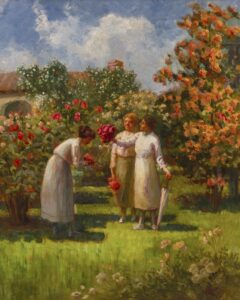JACK AND SHANAZ LANGSON INSTITUTE AND MUSEUM OF CALIFORNIA ART PRESENTS:
HABITAT: MAKING THE CALIFORNIA ENVIRONMENT
ON VIEW SEPTEMBER 20, 2025–JANUARY 10, 2026
EXHIBITION CONSIDERS LANDSCAPE PAINTING FROM THE LATE 19TH AND EARLY 20TH CENTURY AS A TIME CAPSULE OF CALIFORNIA'S NATURAL ENVIRONMENT

Irvine, CA – Jack and Shanaz Langson Institute and Museum of California Art (Langson IMCA) at University of California, Irvine (UCI) today announced its Fall exhibition Habitat: Making the California Environment, on view September 20, 2025–January 10, 2026. Drawing from the museum’s permanent collection and loans from The James Irvine Swinden Family Collection, the exhibition features more than 40 artworks that reflect a pivotal period in the state’s ecological history—after European settlement but before California's landscapes were dramatically changed by urban growth.
Habitat offers a lens into California's environmental past while forging connections with contemporary ecological concerns, from the spread of invasive species to the urgency of preservation. Ultimately, Habitat invites viewers to consider how art, plants, and history have long been connected in shaping the California we know today. Organized into thematic clusters, the works are grouped by subtle yet connective threads—encouraging unexpected juxtapositions and inviting viewers to place California’s habitats and ecosystems in new dialogue.
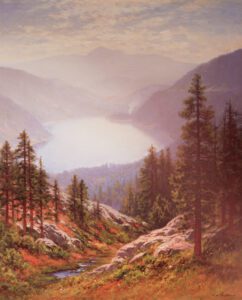
“This exhibition isn’t about illustrating a science lesson but about unpeeling visual and historical layers—revealing how landscape paintings made in California a hundred years ago reflect a complex interplay among colonial, ecological, and aesthetic forces.” said curator Dr. James Nisbet, professor and Chair in the Department of Art History and Ph.D. Program in Visual Studies at the University of California, Irvine.
EXHIBITION THEMES AND HIGHLIGHTS
Habitat will explore topics such as the coexistence of native and non-native plants and the ecological impact of the latter, introduced species; shifts in the appearance of landscapes over the last century; and the ways landscape painting in the late 19th and early 20th centuries enacted a lens created by European artistic traditions for viewing and impacting California’s varied terrains. The exhibition is organized into distinct themes: Native Blooms, Orange County, California Missions, Mountains, and Arboreal Landscapes.
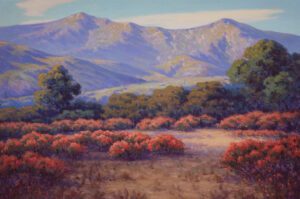
Native Blooms focuses primarily on golden poppies and various lupine species. The golden poppy, which includes the name of California in its Latin designation (Eschscholzia californica), was officially named the state flower in 1903 and—along with the Gold Rush beginning in 1849—is commonly associated with the California’s nickname “the golden state.” John M. Gamble, often credited with popularizing the golden poppy as a Californian symbol, was a leading figure in California Impressionism, and his painting Calce de Oro (Poppy Field near Banning) (circa 1939) enshrines the Riverside County landscape as a symbol of regional identity. Lupines, which often grow alongside poppies, were mistakenly thought to be an invasive species that deplete soil from nutrients, though that paradigm has since been proven incorrect. Untitled (Poppies, Lupines and Cows) (circa 1914) by Spanish-American painter Angel Espoy portrays a meadow of lupines and poppies next to a field of grazing cows, evoking a harmony between nature and agriculture.
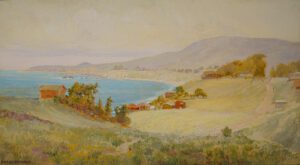 In Orange County, artists explore the beaches, canyons, and orange groves of the county’s native landscape and the encroachment of suburban development. Curtis Chamberlin’s The Old Coast Road (Arch Beach Road) (1915), for instance, is shown in contrast to an anonymous photograph taken the decade prior, and a new house, garden, and trees have been added to Chamberlin’s landscape. Throughout Orange County today, the grasses we see are annual species and mustards. With the introduction of those grasses and the development of the County, southern coastal grasslands have become nearly extinct. In response, a newly commissioned work by contemporary artist and composer Andrew Weathers reimagines Chamberlin’s painting and Arch Beach (1911) by sonically revisiting their original coastal Orange County locations over a century after they were painting. Using advanced audio tools, Weathers’s Landscape Hocket (Orange County) (2025) captures environmental changes over time—both acoustic and ecological—including sonifications of now-rare native grasses.
In Orange County, artists explore the beaches, canyons, and orange groves of the county’s native landscape and the encroachment of suburban development. Curtis Chamberlin’s The Old Coast Road (Arch Beach Road) (1915), for instance, is shown in contrast to an anonymous photograph taken the decade prior, and a new house, garden, and trees have been added to Chamberlin’s landscape. Throughout Orange County today, the grasses we see are annual species and mustards. With the introduction of those grasses and the development of the County, southern coastal grasslands have become nearly extinct. In response, a newly commissioned work by contemporary artist and composer Andrew Weathers reimagines Chamberlin’s painting and Arch Beach (1911) by sonically revisiting their original coastal Orange County locations over a century after they were painting. Using advanced audio tools, Weathers’s Landscape Hocket (Orange County) (2025) captures environmental changes over time—both acoustic and ecological—including sonifications of now-rare native grasses.
The California Missions section examines the impact of California’s Spanish missions, both culturally and ecologically, from 1769 to 1834. While once romanticized, history has begun to recognize the violence enacted by missionaries on Indigenous peoples, their way of life, and the lands they had stewarded for thousands of years. This impact extends to plants as well as these sites introduced invasive plants such as black mustard that continue to alter ecosystems and intensify wildfire risks today. The plants in this section also reveal a growing taste in ornamental gardens, as seen in Julie Mathilde Morrow De Forest’s In the Mission Garden, San Juan Capistrano (1928). The bougainvillea and Mexican fan palms portrayed in this painting still serve as markers of aesthetic appeal and cultural status in contemporary culture.
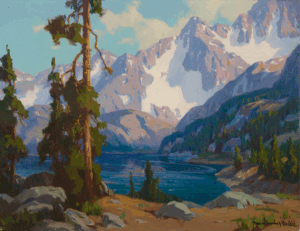
In Mountains, visitors will see how the state’s mountain environments are sparser in vegetation and more rugged than the ecosystems of Orange County and elsewhere across coastal California. While these regions might not have been as directly affected by development, they have been markedly impacted by the climatological changes caused by human activities since the onset of European colonization. Marion Wachtel’s Long Lake, Sierra Nevada (circa 1929), for example, includes both Jeffrey pine and Whitebark pine trees in the lakeside forest. Currently, it would be unusual to find these species growing in the same temperature zone. In response to rising global temperatures, the Jeffrey pine has been moving further upward in elevation and the Whitebark pine moving downward. As shown also in Raymond Yelland’s Donner Lake (1890), the Jeffrey pine has been discovered by researchers at the University of California in early 2025 growing at 12,657 feet, which is 1,860 feet higher in elevation than the highest Jeffrey pine previously recorded. It is now the highest pine species on record.
Celebrating the diversity of California’s trees, Arboreal Landscapes features native giants such as redwoods, oaks, and cypress. Harry Best’s Redwoods (circa 1910) renders these trees as rooted to the forest floor but cropped at the top edge of the canvas, placing viewers in the shadows of the forest and left to imagine how tall the redwood trees rise. In contrast, widespread eucalyptus—imported from Australia in the 1850s—embodies both California’s settler past and present-day wildfire concerns. The trees were initially planted as a potential solution to California’s rapidly increasing population but were proven to be a poor source for lumber. Paul Lauritz’s September Eucalyptus (1923) reflects this complex legacy: his loose Impressionist brushwork shows the trees as both beautiful and iconic while simultaneously representing the ecological change that resulted from mass settlement.
To deepen the exhibition’s interdisciplinary approach, Dr. Nisbet brought on Justin Felder, a California Certified Field Botanist and graduate student in UCI’s Master of Conservation and Restoration Science (MCRS) program, as a consulting expert. This interdisciplinary partnership enriched Habitat with botanical identifications and ecological context, offering insight into the geopolitical histories of the environments depicted.
Dr. James Nisbet is Professor and Chair in the Department of Art History and Ph.D. Program in Visual Studies at the University of California, Irvine. He has published widely on the history and theory of ecocritical visual art and aesthetics from late modernism to the present. His recent book projects include Second Site (Princeton University Press, 2021), and, as editor with Lyle Massey, The Invention of the American Desert: Art, Land, and the Politics of Environment (University of California Press, 2021). Habitat: Making the California Environment marks Dr. Nisbet’s curatorial debut with IMCA.
Public programs will be announced on Langson IMCA’s website at imca.uci.edu.
About UC Irvine Langson Orange County Museum of Art
UC Irvine Langson Orange County Museum of Art (Langson IMCA) is home to two foundational gifts of California Art from The Irvine Museum and Gerald E. Buck estate. In addition, the permanent collection of more than 4,700 works from the late 19th century and early 20th century through present day continues to grow, augmented by acquisitions and gifts. The university is planning to construct a permanent museum and research institute to serve as a global magnet for the presentation and study of California Art within its social, historical, environmental, and cultural frameworks. Langson IMCA is currently located in an interim museum space at 18881 Von Karman Avenue, Suite 100, in Irvine, CA. The Museum is open to all Tuesday through Saturday 10 am to 4 pm. Admission and parking up to two hours are free. For more information, visit imca.uci.edu. Follow us on Instagram @langsonimca.
About the University of California, Irvine
Founded in 1965, UC Irvine is a member of the prestigious Association of American Universities and is ranked among the nation’s top 10 public universities by U.S. News & World Report. The campus has produced five Nobel laureates and is known for its academic achievement, premier research, innovation, and anteater mascot. Led by Chancellor Howard Gillman, UC Irvine has more than 36,000 students and offers 224 degree programs. It’s located in one of the world’s safest and most economically vibrant communities and is Orange County’s second-largest employer, contributing $7 billion annually to the local economy and $8 billion statewide. For more on UC Irvine, visit www.uci.edu.
* * *
Media Contact
For additional information, Emma Jacobson-Sive at EJS Media; emma@ejs-media.com
Image captions
Angel Espoy, Untitled (Poppies, Lupines and Cows), after 1914, Oil on canvas, 30 1/8 x 40 3/8 in. UC Irvine Langson Orange County Museum of Art. Gift of The Irvine Museum
Raymond Dabb Yelland, Donner Lake, 1890, Oil on canvas, 23 x 19 in. UC Irvine Langson Orange County Museum of Art. Gift of The Irvine Museum
John M. Gamble, Red Buckwheat, Santa Barbara, after 1906, Oil on canvas, 28 1/4 x 42 1/4 in. UC Irvine Langson Orange County Museum of Art. Gift of The Irvine Museum
Curtis Chamberlin, The Old Coast Road (Arch Beach Road), after 1917, Oil on board, 19 7/8 x 35 7/8 in. UC Irvine Langson Orange County Museum of Art. Gift of The Irvine Museum
Marion Kavanagh Wachtel, Long Lake, Sierra Nevada, circa 1929, Oil on canvas, 20 1/8 x 26 in. UC Irvine Langson Orange County Museum of Art. Gift of The Irvine Museum

